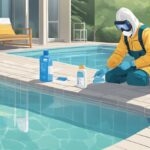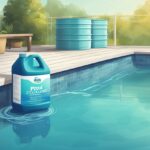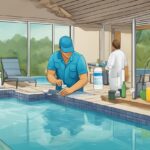Maintaining crystal clear swimming pool water requires a regular balance of chemicals and often necessitates the process known as “shocking” your pool. Shocking refers to the addition of chlorine or non-chlorine chemicals to your pool in high doses to break down contaminants such as chloramines and bacteria. It’s an important aspect of pool maintenance to ensure the water is safe and comfortable for swimmers.
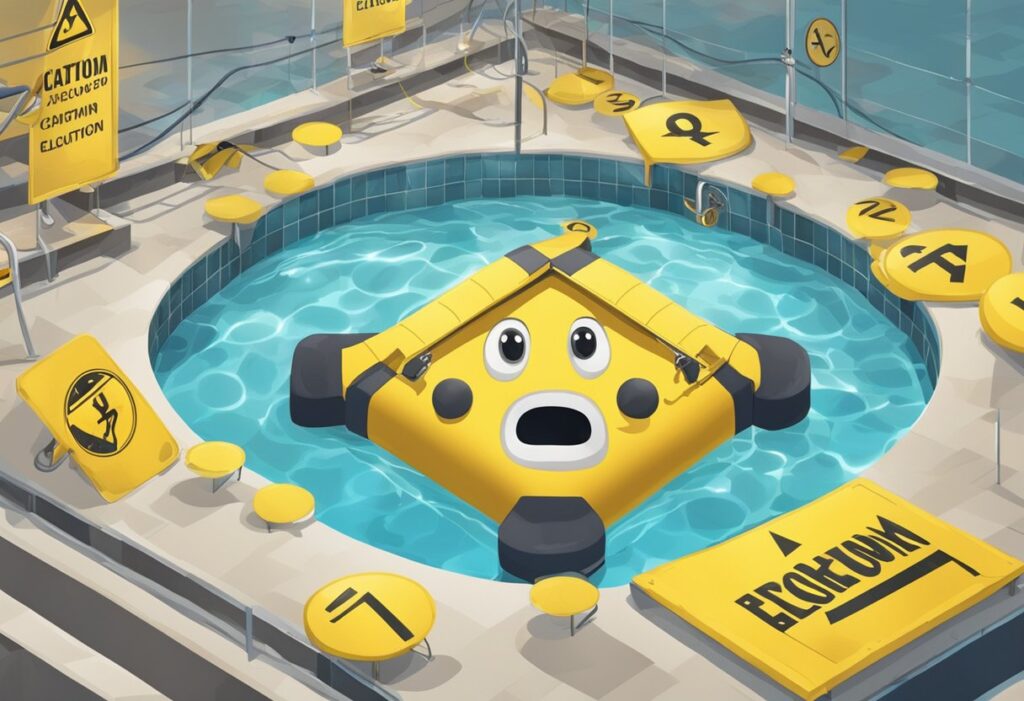
Determining the right amount of shock for your pool involves understanding your pool’s specific needs, which vary based on factors such as the volume of water, frequency of use, and the presence of algae or other contaminants. Generally, for routine maintenance, adding one pound of shock to every 10,000 gallons of water is a good rule of thumb to follow. However, if you’re dealing with a significant algae problem or the water has turned dark green, you’ll likely need to increase the shock dosage to effectively tackle the issue.
It’s also important to consider the type of shock you’re using and its strength, as the required amount can differ for calcium hypochlorite, sodium hypochlorite, or dichlor and trichlor shocks. Regular testing of your pool’s chlorine levels will guide you in maintaining an optimally sanitised pool, as it helps in identifying when and how much shock to apply to maintain a healthy swimming environment.
Understanding Pool Shock and Chlorination
To maintain an efficient and healthy pool, it’s essential to understand pool shock and chlorination. This includes knowing the different types of pool shock, the interaction with cyanuric acid, and the process of breakpoint chlorination.
Types of Pool Shock
Chlorine-based shock typically comes in two main variants: calcium hypochlorite and sodium dichlor. Calcium hypochlorite, also known as cal hypo, is popular and needs to be dissolved before it is added to your pool. Sodium dichlor, on the other hand, is already stabilised and dissolves more readily in water. Additionally, there is non-chlorine shock, which is potassium monopersulfate based and does not increase chlorine levels but does oxidise contaminants effectively.
The Role of Cyanuric Acid (CYA)
Cyanuric acid (CYA), acts as a stabiliser for the chlorine in your pool, protecting it from ultraviolet (UV) light degradation. Ideal CYA levels typically range between 30 to 50 parts per million (ppm). It’s crucial to test your CYA levels to ensure the effectiveness of chlorine, as high levels could lead to chlorine lock, reducing its sanitising ability.
Breakpoint Chlorination Explained
Breakpoint chlorination is the point at which free chlorine becomes sufficient to remove chloramines — the result of chlorine combining with ammonia compounds in the pool, known as combined chlorine. The target is to add enough shock to the pool to achieve a tenfold increase in chlorine level relative to the combined chlorine level, effectively reaching the breakpoint where chloramines are eliminated and you’re left with a pool that’s safe and clean to swim in.
How to Determine the Correct Amount of Shock
The right amount of pool shock depends on your pool’s volume and current chemistry. Ensuring these measurements are accurate is critical for maintaining a healthy swimming environment free of bacteria and algae.
Calculating Pool Volume
To calculate your pool’s volume in litres, use the following formulas depending on your pool shape:
- Rectangular/Square: Length (m) x Width (m) x Average Depth (m) x 1,000
- Circular: Diameter (m) x Diameter (m) x Average Depth (m) x 785
- Oval: 0.5 x Length (m) x Width (m) x Average Depth (m) x 1,000
Remember, the average depth is the shallow end depth plus the deep end depth, divided by two.
Testing Pool Chemistry
Before you shock your pool, test the water to understand the current levels of:
- Chlorine Level: Free chlorine indicates the amount of sanitising chlorine available. A test kit or test strips can measure this.
- pH Level: Aim for a pH between 7.2 and 7.6 to ensure maximum effectiveness of the shock.
- Total Alkalinity: Proper alkalinity levels help stabilise the pH. It should range between 80 and 120 parts per million (ppm).
- Calcium Hardness: Ideal levels are between 200 and 400 ppm to prevent plaster damage.
After determining the water chemistry, assess the shock needed. Typically, for every 10,000 litres of pool water, you would add about 454 grams of shock. If dealing with visible algae growth, double or triple this amount according to the severity. Use high-quality, fresh pool shock to achieve the best results for your pool maintenance.
Executing the Shocking Process
When adding shock to your pool, it’s crucial to handle chemicals safely, choose the right timing for treatment, and follow proper post-shock procedures to ensure effective sanitation and clarity of your pool water.
Safe Handling and Application
Handling Shock: Before you begin, ensure you’re wearing protective gear such as gloves and safety goggles. Open the shock product carefully, avoiding inhalation of fumes or contact with your skin.
Application Methods: For granular shock, pre-dissolve the product in a bucket of water, stirring with a clean plastic stick until fully dissolved. If you’re using liquid shock, it can be poured directly into the pool water.
Dispersion: Turn on your pool pump to circulate the water and distribute the shock evenly throughout the pool. Slowly pour the dissolved granular shock or liquid shock into the water near the return jets to promote swift dispersion.
Timing Your Shock Treatment
Day or Night? Perform the shocking treatment at dusk or during the evening to prevent UV rays from the sun from diminishing the effectiveness of the chlorine.
Pump Running: Ensure your pool pump is operational and running at full capacity during and after the shock treatment to facilitate the circulation of the chemicals.
Post-Shock Procedures
Water Testing: After the shock treatment, it’s imperative to test your pool water to confirm that the level of available chlorine has returned to a safe range for swimming.
Adjusting Chemistry: Post-shock, you may need to add a pool clarifier if the water is still cloudy. The clarifier helps coagulate particles, making them easier for the filter to catch.
Safety Precautions: As a pool owner, make it a rule to wait until your pool’s chlorine levels drop to 3 ppm or lower before deeming it safe to swim. This typically takes 24 hours post-shock.
Remember, maintaining optimal water chemistry is paramount for the health and safety of those using the pool.
Preventing Algae and Bacteria Growth
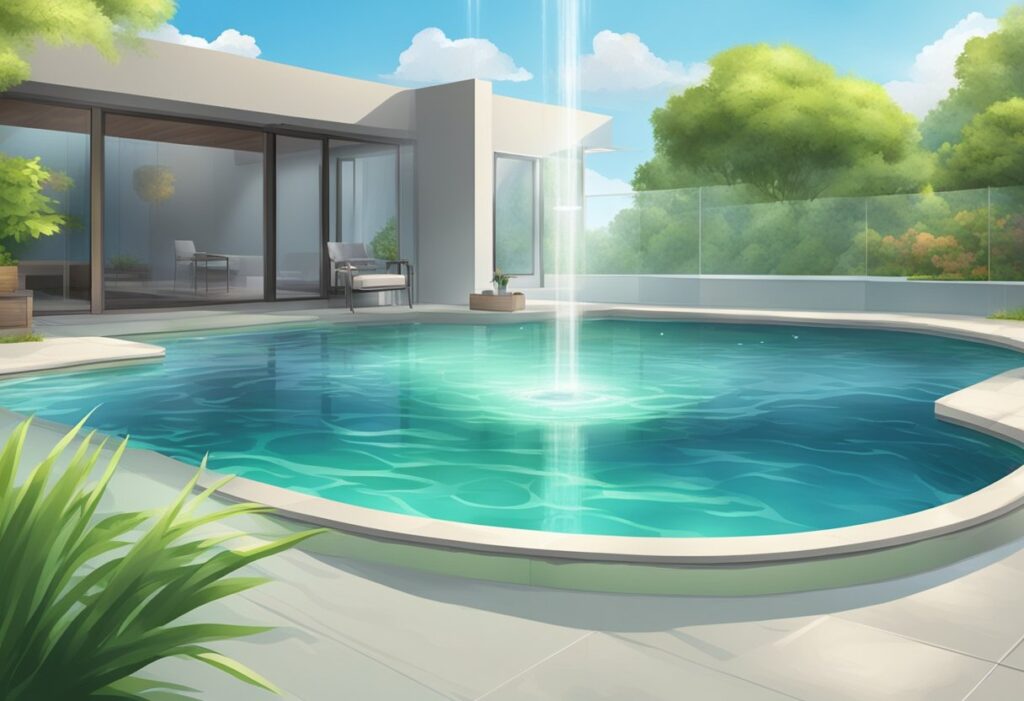
Proper pool maintenance and chemical balance are imperative to prevent the proliferation of algae and bacteria. Not only does this ensure a safe and pleasant swimming environment, but it also extends the longevity of your pool.
Regular Maintenance and Pool Upkeep
It’s essential to keep your pool clean to deter algae and bacteria. Regularly skimming your pool removes debris such as leaves and dust, while vacuuming prevents the buildup of contaminants on the pool floor. After events like a pool party, a thorough cleanup is crucial due to the increased amount of organic material. Additionally, filter maintenance — such as backwashing or replacing the filter media when necessary — plays a pivotal role in keeping the water clear. Regularly check and clear out the skimmer and pump baskets, as well.
Following heavy rain, an increase in debris and dilution of pool chemicals can occur. It’s important to test your water and adjust the chemicals accordingly after such events. Furthermore, ongoing care includes brushing the pool walls and floor to disrupt algae growth and prevent the formation of a welcoming environment for bacteria and algae.
Balancing Chemicals for Optimal Control
Maintaining balanced water chemistry is your second line of defence against bacteria and algae. Here is a focused guide:
- pH Levels: Ideal range is between 7.2 and 7.8. High pH can reduce the effectiveness of chlorine, leading to a chlorine smell indicative of its inefficiency.
- Chlorine: Aim for a free chlorine level of 1-3 ppm to effectively sanitize your pool. Shocking the pool increases chlorine levels and combats algae infestation, particularly following heavy use or when you detect the early stages of algae.
- Cyanuric Acid: Acts as a stabiliser for chlorine, protecting it from being degraded by UV rays and prolonging its efficacy.
- Algaecide: Utilise algaecide as a preventive measure, as it can hinder algae from taking hold in your pool.
Here is a table to help you keep track of the ideal chemical ranges:
| Chemical | Ideal Range | Function |
|---|---|---|
| pH | 7.2 – 7.8 | Balances acidity/alkalinity |
| Free Chlorine | 1 – 3 ppm | Sanitizes pool |
| Cyanuric Acid | 30 – 50 ppm | Stabilises chlorine |
| Total Alkalinity | 80 – 120 ppm | Supports pH stability |
| Calcium Hardness | 200 – 400 ppm | Prevents plaster damage |
Keep a consistent testing routine and adjust pool chemicals as needed. Remember, clear and sanitised water is more than just aesthetically pleasing; it’s crucial for a healthy swimming environment.


